Clomiphene Treatment for Infertility
Jan. 6, 2025, 5:05 p.m.
Clomiphene Treatment for Infertility: A Comprehensive Guide
Clomiphene, widely known as a first-line treatment for infertility, has helped countless individuals on their path to parenthood by stimulating ovulation and enhancing fertility.
Introduction to Clomiphene
Infertility affects numerous couples around the globe, leaving many searching for effective solutions. Among the most recognized fertility drugs used to treat this condition is Clomiphene. This medication has been a beacon of hope for many, offering a non-invasive route to increasing the chances of conception. In this article, we'll delve into everything you need to know about Clomiphene treatment for infertility, providing insights and practical knowledge to assist you on your journey.
How Clomiphene Works
Clomiphene belongs to a class of drugs known as selective estrogen receptor modulators (SERMs). By tricking the brain into thinking there's less estrogen present, it prompts the pituitary gland to release more follicle-stimulating hormone (FSH) and luteinizing hormone (LH). These hormones are crucial for ovulation, making Clomiphene an effective treatment option for those struggling with ovulatory dysfunction.
| Hormone | Role in Fertility |
|---|---|
| Follicle-stimulating hormone (FSH) | Stimulates the growth of ovarian follicles |
| Luteinizing hormone (LH) | Triggers ovulation |
| Estrogen | Regulates menstrual cycle |
This mechanism helps in kick-starting ovulation, especially in women with polycystic ovarian syndrome (PCOS), a common cause of infertility.
Usage Guidelines
Typically, Clomiphene is taken in pill form for five days early in the menstrual cycle. Dosages may be adjusted based on individual response, starting usually at 50 mg per day and potentially increasing if ovulation does not occur. It is important to follow the prescribed guidelines, as misuse can lead to complications or reduced effectiveness.
{
